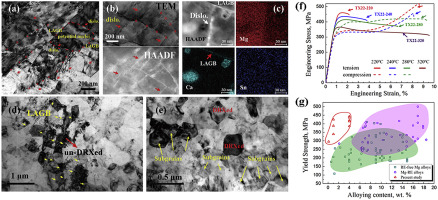当前位置:
X-MOL 学术
›
Acta Mater.
›
论文详情
Our official English website, www.x-mol.net, welcomes your
feedback! (Note: you will need to create a separate account there.)
Development of low-alloyed and rare-earth-free magnesium alloys having ultra-high strength
Acta Materialia ( IF 8.3 ) Pub Date : 2018-05-01 , DOI: 10.1016/j.actamat.2018.03.002 Hucheng Pan , Gaowu Qin , Yunmiao Huang , Yuping Ren , Xuechao Sha , Xiaodong Han , Zhi-Quan Liu , Caifu Li , Xiaolei Wu , Houwen Chen , Cong He , Linjiang Chai , Yunzhi Wang , Jian-feng Nie
Acta Materialia ( IF 8.3 ) Pub Date : 2018-05-01 , DOI: 10.1016/j.actamat.2018.03.002 Hucheng Pan , Gaowu Qin , Yunmiao Huang , Yuping Ren , Xuechao Sha , Xiaodong Han , Zhi-Quan Liu , Caifu Li , Xiaolei Wu , Houwen Chen , Cong He , Linjiang Chai , Yunzhi Wang , Jian-feng Nie

|
Abstract Developing ultra-high strength in rare-earth-free Mg alloys using conventional extrusion process is a great challenge. What is even more difficult is to achieve such a goal at a lower processing cost. In this work, we report a novel low-alloyed Mg-2Sn-2Ca alloy (in wt. %) that exhibits tunable ultra-high tensile yield strength (360–440 MPa) depending on extrusion parameters. More importantly, there is little drop in mechanical properties of this alloy even when it is extruded at a speed several times higher than those used in the reported high strength Mg alloys. Examination of as-extruded microstructures of this Ca-containing Mg alloy reveals that the ultra-high strength is mainly associated with the presence of surprisingly submicron matrix grains (down to ∼0.32 μm). The results suggest that the Ca addition promotes accumulations of the pyramidal dislocations, which eventually transform into the low angular grain boundaries (LAGBs). The high number density of LAGBs separate the α-Mg matrix via either discontinuous dynamic recrystallization (DDRX) mechanism in the early stage or the continuous dynamic recrystallization (CDRX) mechanism in the later stage of extrusion, which effectively enhances the nucleation rates of the DRXed grains. More importantly, large amount of Ca segregation along LAGBs, accompanied with dynamically precipitated Mg2Ca nano-phases, are detected in the present non-severely deformed samples. It is the combination of solute segregations and numerous Mg2Ca nano-precipitates that contributes to the formation of the ultra-fine grains via pinning mechanism. The ultrafine grains size, Ca enrichment in most LAGBs, and residual Mg2Ca nano-precipitates would in turn contribute significantly to the enhancement of the yield strength of the as-extruded Mg-2Sn-2Ca (wt.%) alloy. The low content of alloying elements and the fast one-step extrusion process render the present alloys low-cost and thus have great potential in large-scale industry applications.
中文翻译:

超高强度低合金无稀土镁合金的研制
摘要 使用常规挤压工艺在不含稀土的镁合金中开发超高强度是一项巨大的挑战。更难的是以更低的加工成本实现这样的目标。在这项工作中,我们报告了一种新型低合金 Mg-2Sn-2Ca 合金(重量百分比),根据挤压参数表现出可调的超高拉伸屈服强度(360-440 MPa)。更重要的是,即使以比报道的高强度镁合金中使用的速度高几倍的速度挤出该合金,其机械性能也几乎没有下降。对这种含钙镁合金的挤压微观结构的检查表明,超高强度主要与令人惊讶的亚微米基体晶粒(低至~0.32 μm)的存在有关。结果表明,Ca 的添加促进了锥体位错的积累,最终转变为低角晶界(LAGB)。LAGBs的高数密度通过早期的不连续动态再结晶(DDRX)机制或挤压后期的连续动态再结晶(CDRX)机制将α-Mg基体分离,有效提高了DRXed的成核率谷物。更重要的是,在目前的非严重变形样品中检测到大量沿 LAGB 的 Ca 偏析,伴随着动态沉淀的 Mg2Ca 纳米相。正是溶质偏析和大量 Mg2Ca 纳米沉淀物的结合,有助于通过钉扎机制形成超细晶粒。超细晶粒尺寸,大多数 LAGB 中的 Ca 富集和残留的 Mg2Ca 纳米沉淀物将反过来显着提高挤压态 Mg-2Sn-2Ca (wt.%) 合金的屈服强度。合金元素含量低和快速的一步挤压工艺使本合金成本低,因此在大规模工业应用中具有巨大潜力。
更新日期:2018-05-01
中文翻译:

超高强度低合金无稀土镁合金的研制
摘要 使用常规挤压工艺在不含稀土的镁合金中开发超高强度是一项巨大的挑战。更难的是以更低的加工成本实现这样的目标。在这项工作中,我们报告了一种新型低合金 Mg-2Sn-2Ca 合金(重量百分比),根据挤压参数表现出可调的超高拉伸屈服强度(360-440 MPa)。更重要的是,即使以比报道的高强度镁合金中使用的速度高几倍的速度挤出该合金,其机械性能也几乎没有下降。对这种含钙镁合金的挤压微观结构的检查表明,超高强度主要与令人惊讶的亚微米基体晶粒(低至~0.32 μm)的存在有关。结果表明,Ca 的添加促进了锥体位错的积累,最终转变为低角晶界(LAGB)。LAGBs的高数密度通过早期的不连续动态再结晶(DDRX)机制或挤压后期的连续动态再结晶(CDRX)机制将α-Mg基体分离,有效提高了DRXed的成核率谷物。更重要的是,在目前的非严重变形样品中检测到大量沿 LAGB 的 Ca 偏析,伴随着动态沉淀的 Mg2Ca 纳米相。正是溶质偏析和大量 Mg2Ca 纳米沉淀物的结合,有助于通过钉扎机制形成超细晶粒。超细晶粒尺寸,大多数 LAGB 中的 Ca 富集和残留的 Mg2Ca 纳米沉淀物将反过来显着提高挤压态 Mg-2Sn-2Ca (wt.%) 合金的屈服强度。合金元素含量低和快速的一步挤压工艺使本合金成本低,因此在大规模工业应用中具有巨大潜力。











































 京公网安备 11010802027423号
京公网安备 11010802027423号